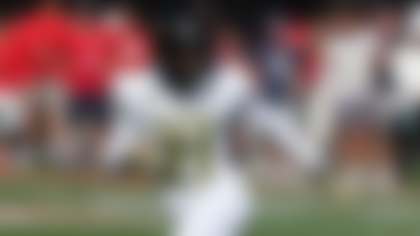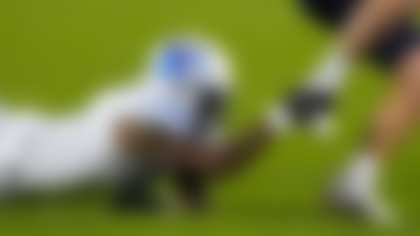Player safety is the top priority for the NFL. Since its earliest days, the league has continuously taken steps to ensure that the game is played as fairly as possible without unnecessary risk to its participants, including making changes and enhancements to game safety rules.
In recent years, the NFL has modified its playing rules to sharply reduce contact to the head and neck of players. These modifications were made separate from, and in addition to, the league's longstanding prohibitions against helmet to helmet contact.
At the start of the training camp each season, the NFL distributes its League Policies for Players manual to all players and coaches as a quick reference guide for some of the most commonly applicable League policies. Topics in the document include player safety equipment guidelines and disciplinary measures for violating game-related player health and safety rules.
To view the review process for on-field rule violations, click here.
For a timeline of rule changes related to health and safety, click here.
Competition Committee
The NFL Competition Committee, currently chaired by Rich McKay, president and former general manager of the Atlanta Falcons, reviews suggested rule changes and presents recommendations to the team owners. While the Committee examines rules and regulations covering all aspects of the game -- from player numbering systems, to ensuring competitive balance, to the usage of retractable roofs -- there is a continuous focus on player safety. The Committee performs a seasonal review of statistics in the league, including injury data provided by the Injury and Safety Committee. The Committee solicits input from the clubs through a survey, and then thoroughly evaluates all suggested changes. In addition, the NFLPA and player representatives offer input on the rules and state of the game. In 2010, the Committee also met with the NCAA and college football representatives to share ideas with respect to player safety and the state of the game at the collegiate level, with the understanding that rule changes at the NFL level have a strong affect on rules at all levels of play. After reviewing statistics and considering suggestions from team owners and the NFLPA, the Committee presents recommendations on rules modifications or changes to the team owners. A change requires 24 of the 32 owners to vote yes.
In 2009, several key rule changes were approved by NFL team owners which eliminated many unnecessary hits on defenseless players and linemen. These changes included making it illegal for a defensive player to hit a defenseless receiver in the head or neck area with a hit using the forearm or shoulder, in addition to the current prohibition against helmet-to-helmet hits. New protections were also afforded to defenders, making it illegal for an offensive player to deliver a blindside block by using the helmet, shoulder or forearm to deliver a blow to a defensive player's head or neck area. Additional safety-related rules in connection to kickoffs and kickoff returns were also approved.
Player Safety Advisory Panel
Commissioner Roger Goodell appointed Hall of Fame NFL coach and legendary broadcaster John Madden and Hall of Fame player Ronnie Lott as the co-chairs of a new panel of coaches formed to explore ways of improving player safety. Panel members include former players, coaches and NFL executives. The Panel's mission is to take a long-term view towards making the game safer for all players at every level of the sport. The Panel reviews all aspects of the game including playing rules, techniques, strategies, training methods, safety-related studies and equipment standards, among others. The panel weighs considerations such as reducing the overall amount of offseason work, and/or limiting the use of helmets (and therefore contact) in practice, minicamps, Organized Team Activity (OTA's), and training camps. Formal recommendations from the panel will be submitted directly to the Competition Committee and Commissioner Goodell.
Discipline for Violation of Rules
The NFL recognizes that safety cannot be promoted exclusively through interpretation of existing rules or adoption of new legislation, and that the participants on the field must assume responsibility for ensuring safe play. Accordingly, to give further force and effect to player safety rules, the league will impose fines and/or other discipline for rule violations. The league has increased the level of discipline and enforcement for violations of existing rules.
The process for a play to be reviewed for potential disciplinary action starts with the NFL Officiating Department reviewing every play of every game. Any play involving a violation that needs to be reviewed for possible discipline, whether flagged on the field or not, is referred to Executive Vice President of Football Operations Ray Anderson and his staff, which includes Vice President of Football Operations Merton Hanks, a nine-year NFL veteran (1991-99). Merton Hanks or Ray Anderson make the initial determination for discipline for on-field violations.
The player has the right to appeal league discipline. The Collective Bargaining Agreement specifies that appeals of fines or suspensions of players for unnecessary roughness or unsportsmanlike conduct are determined by the Commissioner's designee. The decision on persons appointed as the Commissioner's designee for on-field player discipline appeals are determined by the Commissioner or one of two hearing officers who are jointly-appointed by the NFL and NFLPA. Those designated appeal officers are former NFL coach Art Shell and by former NFL coach Ted Cottrell. Shell and Cottrell are appointed and paid jointly by the NFL and NFLPA.
Fine money from on-field and some off-field player fines is donated through NFL Charities to programs for retired players via the NFL Player Care Foundation and the NFLPA's Players Assistance Trust. This fine money has netted an average of approximately $4 million per year over the last four years for distribution to those charitable organizations.
Return-to-Play
The NFL has a firmly established policy concerning the treatment of concussions. In 2009, the NFL adopted a stricter statement on return-to-play for a player who sustains a concussion.
The stricter 2009 statement on return-to-play was developed by the NFL's medical committee on concussions in conjunction with team doctors, outside medical experts, and the NFL Players Association in order to provide more specificity in making return-to-play decisions. The new guidance supplemented the 2007 statement on return-to-play that encouraged team physicians and athletic trainers to continue to take a conservative approach to treating concussions and established that a player should not return to the same game after a concussion if the team medical staff determined that he had lost consciousness.
The 2009 statement advises that a player who suffers a concussion should not return to play or practice on the same day if he shows any signs or symptoms of a concussion that are outlined in the return-to-play statement. It further states:
"Once removed for the duration of a practice or game, the player should not be considered for return-to-football activities until he is fully asymptomatic, both at rest and after exertion, has a normal neurological examination, normal neuropsychological testing, and has been cleared to return by both his team physician(s) and the independent neurological consultant. A critical element of managing concussions is candid reporting by players of their symptoms following an injury. Accordingly, players are to be encouraged to be candid with team medical staffs and fully disclose any signs or symptoms that may be associated with a concussion."
Based on the 2009 statement, a player who suffers a concussion should not return to play or practice on the same day if any of the following symptoms or signs is identified based on the initial medical evaluation of the player:
- Loss of consciousness;
- Confusion as evidenced by disorientation to person, time or place; inability to respond appropriately to questions; or inability to remember assignments or plays
- Amnesia as evidenced by a gap in memory for events occurring just prior to the injury; inability to learn and retain new information; or a gap in memory for events that occurred after the injury;
- Abnormal neurological examination, such as abnormal pupillary response, persistent dizziness or vertigo, or abnormal balance on sideline testing;
- New and persistent headache, particularly if accompanied by photosensitivity, nausea, vomiting or dizziness;
- Any other persistent signs or symptoms of concussion.
Alcohol and Other Substances of Abuse
The NFL substance abuse policy protects player health by clearly defining substance abuse, and providing an intervention program for players in need.
Players are prohibited from the use, possession, or distribution of illegal drugs, as well as the abuse of prescription drugs, over-the-counter drugs and alcohol.
The cornerstone of the NFL's substance abuse policy is its confidential, three-stage intervention program designed to assist players. Each stage is comprised of varying levels of treatment, evaluation, testing and discipline as needed. Players enter the intervention program if they test positive for substance abuse, exhibit behavior or symptoms of substance abuse, or through self referral. In order to support their sobriety, players remain in the program for a minimum of two years and potentially throughout their NFL careers.
Each NFL team has a Team Substance Abuse Physician who oversees the progress of all intervention program participants. The intervention program is reviewed quarterly to ensure that the program successfully meets player needs.
Anabolic Steroids and Related Substances
Performance enhancing drugs are a threat to the fairness and integrity of athletic competition. The use of these substances can lead to health risks, on-the-field injuries, alienation of fans, diminished job performance and personal hardship. Steroid use has been linked to a number of physiological, psychological, orthopedic, reproductive, and other serious health problems, including heart disease, liver cancer, musculoskeletal growth defects, strokes and infertility.
In order to protect players and maintain the integrity of the game, the NFL prohibits the use of anabolic/androgenic steroids (including exogenous testosterone), stimulants, human or animal growth hormones, whether natural or synthetic, and related or similar substances. This policy extends to coaches, trainers, physicians and all other club personnel, ensuring they do not condone, encourage, supply or prescribe these substances.
As part of the new Collective Bargaining Agreement, the NFL and the NFL Players Association committed for the first time to implementing comprehensive, year-round random testing for human growth hormone. The League has put forward a detailed plan of collection, testing and adjudication. If adopted by the Players Association, the NFL will become the first major American sports league to implement blood testing for human growth hormone. Language from the CBA follows:
*Language adapted from 2011 League Policies for Players. *
- UPDATE: In December 2012, the NFL announced the creation of the National Football League Foundation (NFL Foundation) following an update to the structure of the NFL's philanthropic organizations. The NFL Youth Football Fund was merged with NFL Charities and then renamed NFL Foundation. For more information about the NFL Foundation, visit: www.nflfoundation.org.



